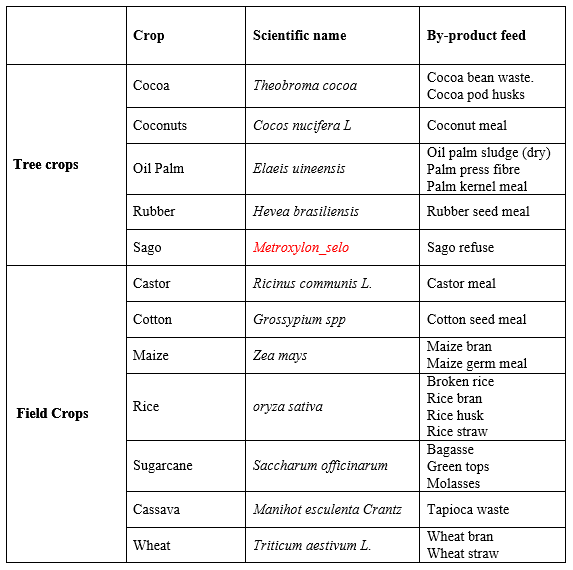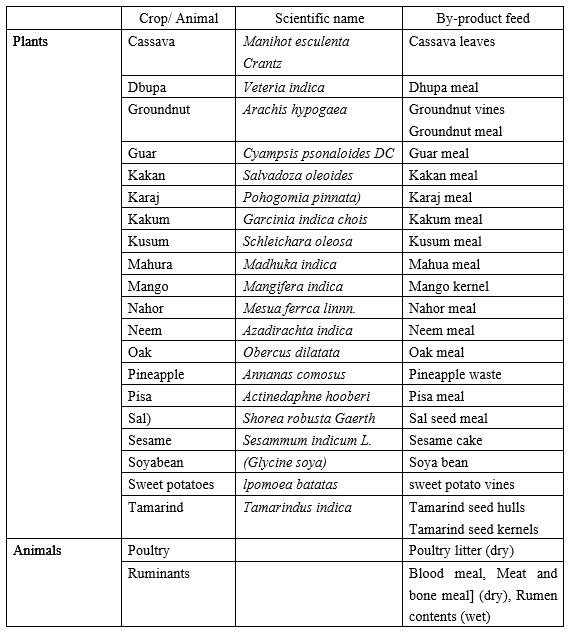Non-Conventional Feeds and Agro Industrial By Products: Their Scope and Future Demand for Livestock Production
Published: June 5, 2014
By: Dr. Umesh Sontakke, Vishnu Kale, Bisitha Bose and Muneendra Kumar (Dairy Cattle Nutrition Division
National Dairy Research Institute)
Introduction
India is basically an agricultural country and about 70 per cent of its people live in villages. Their livelihood is dependent mainly on agriculture and animal husbandry. Though India has a huge livestock population of over 343 millions, besides poultry, yet the production of per animal milk and other livestock products is about the lowest in the world. It is evident that we are highly deficient in various livestock products, though we have about one-fourth of the total cattle population of the world. The analysis of this situation reveals that one of the main reasons for the low productivity of our livestock is malnutrition, under-nutrition or both, besides the low genetic potential of the animals.
Availability, vis-a-vis the requirement of green-fodder crops and concentrates, that there is a huge gap between demand and supply of all kinds of feeds and fodders. On the other hand, if we examine the land resources available for growing fodder and forage crops, it is estimated that the average cultivated area devoted to fodder production is only 4.4 per cent of the total area. Similarly, the area under permanent pastures and cultivable wastelands is approximately 13 and 15 million hectares respectively. Likewise, the total area under forests is 2.51 crore hectares and that open to grazing is 2.1 crore hectares. All these resources are able to meet the forage requirements of the grazing animals only during the monsoon season. But for the remaining periods of the year, the animals have to be maintained on the crop residues or straws of jowar, bajra, ragi, wheat, barley, etc. either in the form of whole straw or a bhusa, supplemented with some green fodder, or as sole feed. The crop residues are available mainly from wheat, paddy, bajra, jowar, ragi, sugarcane trash, etc. But now it is necessary to search and increase the nutrient utilization of crop residues as well as nonconventional feeds.
Non-conventional feed resources (NCFR):
The non-conventional feed resources (NCFR) refer to all those feeds that have not been traditionally used in animal feeding and or are not normally used in commercially produced rations for livestock. NCFR include commonly, a variety of feeds from perennial crops and feeds of animal and industrial origin. The term NCFR has been frequently used to describe such new sources of feedstuffs as palet oil mill effluent and palm press fibre (oil palm by-products), single cell proteins, and feed material derived from agro industrial by-products of plant and animal origin. Poor-quality cellulosic roughages from farm residues such as stubbles, haulms, vines and from other agro-industrial by-products such as slaughter-house by-products and those from the processing of sugar, cereal grains, citrus fruits and vegetables from the processing of food for human consumption also comes under category of NCFR.
Need of Non-conventional feed resources:
There are serious shortages in animal feeds of the conventional type. The grains are required almost exclusively for human consumption. With increasing demand for livestock products as a result of rapid growth in the world economies and shrinking land area, future hopes of feeding the animals and safeguarding their food security will depend on the better utilization of unconventional feed resources which do not compete with human food. The availability of feed resources and their rational utilization for livestock represents possibly the most compelling task facing planners and animal scientists in the world. The situation is acute in numerous developing countries where chronic annual feed deficits and increasing animal populations are common, thus making the problem a continuing saga.
Thus non-conventional feeds could partly fill the gap in the feed supply, decrease competition for food between humans and animals, reduce feed cost, and contribute to self-sufficiency in nutrients from locally available feed sources. It is therefore imperative to examine for cheaper non-conventional feed resources that can improve intake and digestibility of low quality forages. Feedstuffs such as fish offal, duckweed and kitchen leftovers (i.e., potato peel, carrot peel, onion peel, and cabbage leftover), poultry litter, algae/Spirulina, Leucaena leaf, local brewery and distillery by-products, sisal waste, cactus, coffee parchment and coffee pulp are commonly used in India, and could be invaluable feed resources for small and medium size holders of livestock.
Advantages of NCFR:
a) These are end products of production and consumption that have not been used.
b) They are mainly organic and can be in a solid, slurry or liquid form. Their economic value is often very less.
c) Fruit wastes such as banana rejects and pineapple pulp by comparison have sugars which are energetically very beneficial.
d) The feed crops which generate valuable NCFR are excellent sources of fermentable carbohydrates eg. cassava and sweet potato and this is an advantage to ruminants because of their ability to utilize inorganic nitrogen.
e) Concerning the feeds of crop origin, the majority are bulky poor-quality cellulosic roughages with a high crude fibre and low nitrogen contents, suitable for feeding to ruminants.
f) They have considerable potential as feed materials and their value can be increased if they are converted into some usable products.
Agro-industrial by-products
Appropriate use of relatively inexpensive agricultural and industrial by-products is of paramount importance for profitable livestock production. However, high cost and low availability of conventional livestock feedstuffs frequently demand consideration of by-products even if efficiency of utilization is low. Efficient use of by-products relies on their chemical and physical properties, which influence production system outputs. In developing countries, grain, which forms the bulk of concentrate feeds for livestock, is both in short supply and expensive due to direct competition with human food uses.
Natural pasture that is estimated to contribute to 80–90% of livestock feeds and whose quality is seasonally variable is the main source of feed in arid and semi-arid pastoral areas, while crop residues contribute up to 50% of the feed supply in mixed-farming system. Grazing lands are steadily shrinking by conversion to arable lands, and natural pastures are also restricted to areas that are marginal and have little farming potential. The reduction in natural pasture has led to overutilization and domination by undesirable forage species resulting in partial dependence on crop residues by most ruminants, which has reduced livestock productivity. The increasing human demands for several foods (i.e. olive oil, vegetables, wine, fruit juices, etc.) led to a considerable increase of lands occupied by crops producing these feeds. Consequently, huge amounts of agro-industrial by-products are available in numerous developing countries (e.g. molasses, olive cake, winery marc, etc.), which are still not fully utilized in livestock feeding. Most of these AIBPs are low in main nutrients. Moreover, the difficulty of the use of these feed sources as fresh material for extended periods and the lack of efficient ways for their integration in feeding calendars may account for their under-utilization.
MAJOR BY-PRODUCT FEEDS FROM TREE AND CROPS

MINOR BY-PRODUCT FEEDS FROM VARIOUS SOURCES

Conclusion
The main reason for the poor animal production is the inadequate supply and low level of feeding due to serious shortage of feedstuffs. A major gap exists between the requirements and supplies of nutrients for feeding of animal, the non conventional feeds could partly fill this gap. More information is required on chemical composition, nutritive value and their utilization. Farmers are not aware of the nutritive value of some feed sources and the way for their efficient integration in livestock feeding. The involvement of local extension agencies in technology development for efficient use of NCFR, assessment and transfer is equally important. Several factors may account for their limited use, among which is their low nutritive value, Seasonal availability, high cost of handling and transportation from the production site to the farm, presence of anti-nutritional factors. It is essential to increase feeds by growing more fodders, propagating agro and social forestry, improving the nutritive value of crop residues and utilising other NCFRs. Crop residues, AIBPs and browse foliage are certain an increasingly important role as feeds in the future, as human and livestock populations expand.
References:
Bakshi, M.P.S. and Fontenot, J.P. (1998). Processing and nutritive evaluation of broiler litter as livestock feed. Anim. Feed Sci. Technol. 74: 337-345
Farag, M.D.E.H. (2001). The enhancement of the nutritive value of mango seed kernels for poultry by thermal treatment and radiation processing. Archives of Anim. Nutr. 54(1): 61-79
ICAR (2006). Agricultural Research Data Book 2006 ICAR, Krishi Bhawan, New Delhi. 341pp
Jakmola, R. C. (2005). Evaluation of locally available feed and fodder to improve the quality and formulate the complete economic rations with high roughage diet. Final Reports (1999-2005) National Agricultural Technology Project, CSWRI, Avikanagar, 67 p.
Joseph, J. K. and Abolaji, J. (1997). Effects of replacing maize with graded levels of cooked Nigerian mango-seed kernels (Mangifera indica) on the performance, carcass yield and meat quality of broiler chickens. Bioresource Technol. 61(1): 99-102
Joshi, A. L., Thole, N.S., Waghmare, B.S. and Rangnekar, D. V. (1985). Nutritive evaluation of kokam extract. Indian J. Anim. Sci. 55: 381-385
Mekashaa, Y., Azage Tegegneb, A., Yamic, A. and Umunnab, N.N. (2002). Evaluation of non-conventional agro-industrial by-products as supplementary feeds for ruminants: in vitro and metabolism study with sheep. Small Ruminant Res. 44: 25–35
Mekashaa, Y., Azage Tegegneb, A., Yamic, A. Umunnab, N.N. and Nsahlai, I.V. (2003). Effects of supplementation of grass hay with non-conventional agro-industrial by-products on rumen fermentation characteristics and microbial nitrogen supply in rams. Small Ruminant Res. 50: 141–151
Mishra, A. K., Tripathi, M. K., Misra, A. S., and Jhakmola, R. C. (2003). Scope and future role of nonconventional feed in ruminant feeding in sustainable animal production (ed. R. C. Jhakmola and R. K. Jain), Pointer Publisher Jaipur, pp.376-398
Patel, B.M., Patel, C.A. and Talpada, P.M. (1972). Evaluation of mango seed kernels and tomato waste in the ration of bullocks. Ind. J. of Nutr. And Dietetics., 9(6): 347-350
Paul, B. N., Gupta, B. S., Srivastava, J. P., and Bhakt, R (1994) Effect of feeding unconventional cakes and poultry manure mixture on voluntary intake of feed and nutrient utilization in growing cross-bred calves. Indian J. Anim. Nutr. 11(1): 39-42
Paul, B.N., Gupta, B.S., Srivastava, J.P., and Bhakt, R. (1997). Dry matter and protein degradability of some unconventional feed ingredients and poultry manure mixture in ruminants. Indian J. Anim. Health. 36(1): 23-26
Prasad, R. and Jhakmola, R. C. (2003). Improvement of low grade roughages and crop residue in sustainable animal production (ed. R. C. Jhacmola and R. K. Jain), Pointer Publisher Jaipur, pp. 298-331
Ranjhan, S. K. (2003). Livestock and feed situation in India sustainable animal production (ed. R. C. Jhakmola and R. K. Jain), Pointer Publisher Jaipur, pp. 1-24
Ravindran, V and Rajaguru, A. S. B. (1985) Nutrient contents of some unconventional poultry feeds. Indian J. Anim. Sci. 55(1): 58-61
Reddy, E.P, and Prasad, D.A. (1985). Evaluation of economic concentrate mixtures for dairy cattle. Cheiron. 14(4): 164-172
Reddy, T.S. (1987). Use of non-conventional feed items in poultry rations, their effect on growth and egg production. Poultry Adviser. 20: 1, 33-36
Saha, K. C. and Bhattacharyya, B. (1995). Growth performances and some blood constituents in grower quail (Coturnix coturnix japonica) reared on unconventional feed. Ind. Vet. J. 72(2): 183-184
Vasta, V., Nudda, A., Cannas, A., Lanza, M. and Priolo, A. (2008). Alternative feed resources and their effects on the quality of meat and milk from small ruminants. Anim. Feed Sci. Technol. 147: 223–246
Related topics:
Authors:
National Dairy Research Institute (NDRI)
Recommend
Comment
Share
27 de septiembre de 2021
Am a student of ladoke Akin told University of technology Ogbomosho oyo state Nigeria, please i want a project write up on Challenges and Prospect of non conventional feed resources
Recommend
Reply
27 de agosto de 2021
Great article Sontakke sir :))
Helped me to alot to complete an assignment.
Rounak Singh
BVSc AH student at Ranchi Veterinary College
Recommend
Reply
3 de julio de 2015
I n my openion, Non-Conventional Feeds and Agro Industrial By Products have key roles in iran because in my country we have shortage of feeds and water supply for planting new forage resources. The nutritive value of most of Non-Conventional Feeds and Agro Industrial By Products in Iran determined.
the most problem for use of is gathering an pelleting of them as TMR diet.
Recommend
Reply
29 de junio de 2015
Natural pasture that is estimated to contribute to
80–90% of livestock feeds and whose quality is
seasonally variable is the main source of feed in
arid and semi-arid pastoral areas, while crop
residues contribute up to 50% of the feed supply in
mixed-farming system. Grazing lands are steadily
shrinking by conversion to arable lands, and
natural pastures are also restricted to areas that
are marginal and have little farming potential. The
reduction in natural pasture has led to
overutilization and domination by undesirable
forage species resulting in partial dependence on
crop residues by most ruminants, which has
reduced livestock productivity. The increasing
human demands for several foods (i.e. olive oil,
vegetables, wine, fruit juices, etc.) led to a
considerable increase of lands occupied by crops
producing these feeds. Consequently, huge
amounts of agro-industrial by-products are
available in numerous developing countries (e.g.
molasses, olive cake, winery marc, etc.), which are
still not fully utilized in livestock feeding. Most of
these AIBPs are low in main nutrients. Moreover,
the difficulty of the use of these feed sources as
fresh material for extended periods and the lack of
efficient ways for their integration in feeding
calendars may account for their under-utilization.
Recommend
Reply
Recommend
Reply
21 de agosto de 2014
In the net we could also find articles about chlorella. But as farmer we don,t know how to grow and utilise them . please guide
Recommend
Reply
21 de agosto de 2014
Namasthe.
Please let me know the addresses of the dairies which use single cell protein and spirulina.
Vandane
Ananda,organic farmer, karnataka
anand_kpp@rediffmail.com
Recommend
Reply
18 de julio de 2014
India farmers has to be encouraged by effective extension techniques in usage of these non conventional substitutes but these are to be supported by the quantification i.e amount of material can safely used/animals & need integration of research work in these lines of safety levels & toxic effects & remedies of toxicity so as to handle overgrazed/overfed
Recommend
Reply
1 de julio de 2014
Re: Non-Conventional Feeds and Agro Industrial By Products: Their Scope and Future Demand for Livestock Production
07/01/2014. Dr Sontakke, I must admit the fact that this article has been published at the right time where there exist a competitive demand for the conventional livestock feed ingredients by humans and industries. Hence, this may contribute to solving the problem of short supply of feedstuffs for the livestock industry. KEEP IT UP SIR! --------- ALBERT KANU, CROSS RIVER STATE, NIGERIA
Recommend
Reply
19 de junio de 2014
Dr.Sontakke,very good article in the present context as we have to explore the alternative feed resources to feed our ever growing animal population.keep it up and explore the new areas---- Dr.MBA SIDDIQUI,BVC,MUMBAI
Recommend
Reply

Would you like to discuss another topic? Create a new post to engage with experts in the community.




.jpg&w=3840&q=75)







.jpg&w=3840&q=75)